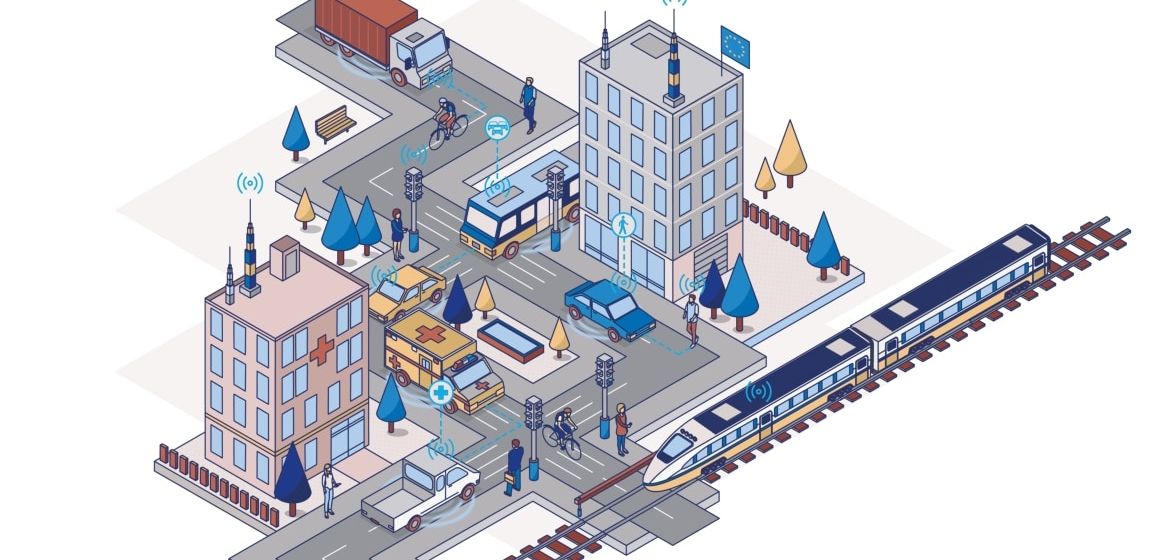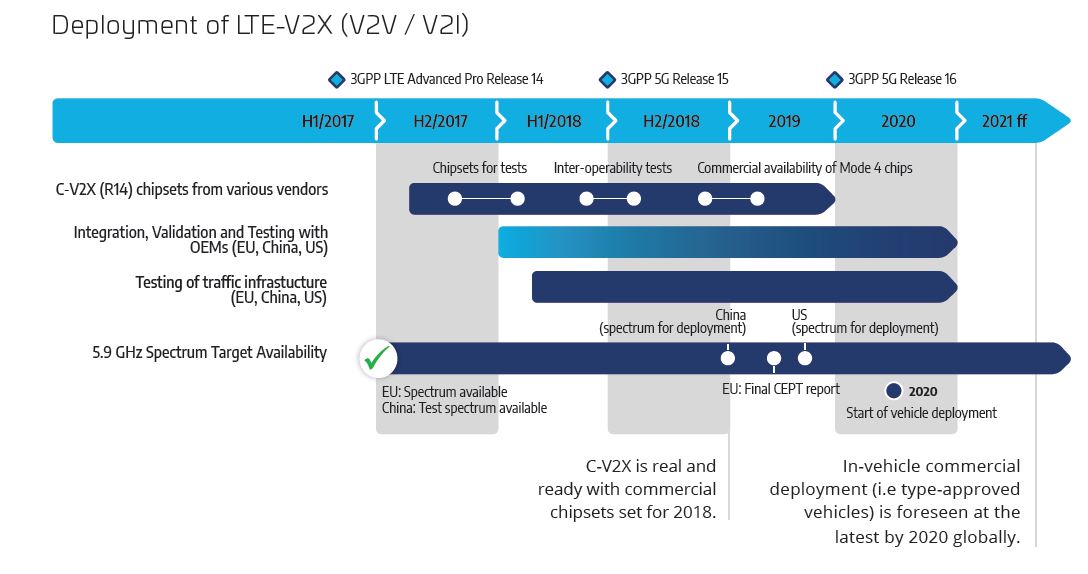
5GAA Connected and Automated Driving Workshop, Showcase and Demonstration Overview – 23 May 2019 – Berlin, Germany
The 5G Automotive Association (5GAA), a global, cross-industry organisation with over 115 members working together to develop end-to-end solutions for future mobility and transportation services, is pleased to invite you to the upcoming international workshop on “Connected and Automated Driving” in Berlin on May 23, 2019.
The workshop will gather EU and Member State policy makers from national and local levels, trade associations, 5GAA members and other industry representatives from the automotive and the telecommunications sectors.
The focus of the workshop will be on key issues of the global progress in the field of Connected, Cooperative and Automated Mobility and related challenges of cross-border automated driving, especially in Europe, and the current needs for connected mobility in both rural and urban mobility contexts.
In the afternoon, live demonstrations of C-V2X enabled connected cars, traffic infrastructure and other road users will take place on a fairground close to Tegel Airport (registration required), accompanied by a showcase of C-V2X technology that is ready to positively contribute to increase safety, especially for vulnerable road users, on roads across the world.
Due to limited capacity, the Workshop, Showcase and Demonstration is by invitation only to the groups mentioned above; if you are part of one of these groups please contact liaison@5gaa.org for more information.
Click here to discover the programme of the international workshop.

5GAA discusses the role of non-terrestrial networks in the connectivity of the car of the future
Ubiquitous connectivity is an essential prerequisite to achieving a full-scale digital transformation of the automotive sector. Connectivity challenges and how the seamless integration of terrestrial and non-terrestrial network solutions can foster high-capacity global connectivity were at the heart of the Connectivity for the Car of the Future Symposium, hosted by the 5G Automotive Association (5GAA).
Berlin (Germany), 16 May 2022. The 5G Automotive Association (5GAA) and the European Space Agency discussed the crucial role of ubiquitous connectivity and the opportunities for space technologies to offer future solutions for the automotive sector during its “Connectivity for the Car of the Future Symposium.”
Today, over 200 million connected vehicles worldwide are equipped with applications sharing hazard and traffic warnings on the road. The automotive sector is undergoing a significant transformation: from a focus on vehicle performance to a focus on a fully digital, tailor-made digital experience, and customers increasingly expect a fully connected car. Ubiquitous connectivity is an essential prerequisite to achieving a full-scale digital transformation of the automotive sector. Ensuring the network’s reliability can be a challenge, particularly in rural or remote areas that still experience no or poor band coverage, and non-terrestrial networks can have a crucial role in deploying hybrid connectivity solutions for the car of the future.
To explore the connectivity challenges and how space solutions can support the car industry in connected mobility, the 5G Automotive Association organised a Symposium in collaboration with the European Space Agency (ESA). What does the future car look like? Which connectivity and business models are needed to enable? What is the place of space in the mix? These were some of the questions addressed by industry representatives of car manufacturers, connectivity providers, mobile network operators, satellite connectivity providers and decision-makers.
Satellite connectivity can complement terrestrial solutions in white spots and in case of outages and congestion. In this sense, Europe must accelerate the development of assets and capacities in this field to compete globally, provide the appropriate solutions for the automotive sector and fill in any potential gaps. Therefore, it is essential to ensure that all the stakeholders and their respective innovative roadmaps are aligned, as highlighted by Joseph Aschbacher, Director-General of ESA, in his welcome messagefor the event. As such, the car industry will be able to make the most of cutting-edge developments in the connectivity domain.
“We are pleased to collaborate with 5GAA to promote and build the connected car ecosystem of the future. Vehicles are rapidly becoming fully connected devices and drive investments into new-generation connectivity. Satellites and space-based technologies are key assets to complete terrestrial networks, build smart and hybrid systems and offer ubiquitous, secure, and sustainable connectivity. We look forward to continuing this intense exchange with the automotive value chain to join forces and build a truly European connected car architecture,” added Elodie Viau, Director, Telecommunications and Integrated Applications Directorate, ESA.
During the Symposium, car manufacturers and tier-1 suppliers discussed the mobility-related technology innovations, opportunities, requirements, and challenges, highlighting the crucial role of ubiquitous connectivity for the automotive sector and the increasing number of use-cases already developed by the automotive industry for both private and commercial vehicles.
Including non-terrestrial connectivity in the mix will bring many benefits, such as extending high connectivity to rural areas at a comparatively low cost and enabling digital services and autonomous driving applications. However, space solutions need to be integrated with the existing terrestrial solutions, as they will not replace them. In addition, the seamless integration of antennas technology on the car, and the smooth handover between the networks, are just some of the challenges that still need to be addressed. Therefore, speakers pointed out that these solutions need to be included in the 3GPP standardisation system, which is currently the integrational connectivity path, defining the terrestrial connectivity requirements.
Finally, all the stakeholders engaged in a lively discussion to map how the whole ecosystem can work together to address the connectivity challenges and develop targeted R&D, demonstrators and pilots and expand them into mature business models and strategic partnerships. Indeed, to enable cross-border coordination and integration of terrestrial and satellite connectivity solutions, the cooperation and alignment of various players and investments will be essential. In this area, ESA aims to provide the European automotive sector with the necessary support and expertise to maximise its positive social, economic and environmental impact and develop competitive car connectivity solutions.
“Use cases and requirements are already there, and ubiquitous connectivity will enable their full-scale deployment. Satellite solutions can play a crucial role in achieving this,” concluded Johannes Springer, Director General, 5GAA. “It is crucial to ensure the greatest alignment and cooperation between all the stakeholders involved. Let’s continue working together to bring the 3GPP standards to the satellite solutions and seamlessly integrate them with the terrestrial networks to provide solutions for the car of the future.”
Below the presentations showcased during the first session of the event:
Andreas Schaller, V2X Technology Strategy, Robert Bosch Mobility Solutions
Olaf Eckart, Senior Expert Cooperations R&D, Industry Customers, BMW
Jörg Plechinger, Head of Mobile Connectivity Plattform / Car2X, AUDI AG
Susanne Schulz, Head of Department Cooperative, Connected and Automated Mobility, Autobahn GmbH




5GAA to organise the “C-V2X: Ready to Deploy” Workshop and live demonstrations of C-V2X technology in Atlanta, GA.
On May 12, the 5G Automotive Association (5GAA) will organise a workshop on “C-V2X: Ready to Deploy”, bringing together infrastructure owners and operators and the broader ecosystem stakeholders to disclose the benefits of C-V2X for traffic safety. The workshop will be followed in the afternoon by a series of live C-V2X technology demonstrations.
After more than two years of virtual meetings, the 5G Automotive Association will be back to a face-to-face meeting week, which will take place from May 9 to 13 in Atlanta, GA, and allow 5GAA members to catch up on the latest development of the association and its activities.
As part of the week, on May 12, from 9 AM to 12 PM EDT, 5GAA will hold a workshop on “C-V2X: Ready to Deploy”, bringing together infrastructure owners and operators, car manufacturers and suppliers, leading technology companies and research institutions to discover the benefits of C-V2X for traffic safety.
A family of technologies that can be tailored for all needs, C-V2X provides solutions for rural, regional and national infrastructure challenges by using connectivity to prioritise safety for all road users. The panel discussions will explore the adaptability of C-V2X solutions for different community needs and how IOOs and local authorities can leverage the opportunities of the Infrastructure, Investment and Jobs Act to modernise their operations.
The event will take place at the Grand Hyatt hotel in Buckhead, Atlanta. It will feature keynote speeches from local and regional DOT and representatives of 5GAA’s member companies, such as Applied Information and Audi of America.
In addition, 5GAA’s members showcase live demonstrations of C-V2X use cases open to local authorities and other stakeholders during the afternoon. The demonstrations will occur in two locations: the Alpharetta Infrastructure Automotive Technology Laboratory, iATL and the Peachtree Corners Curiosity Lab.
Find here the agenda of the workshop and the scheduled demos.
The list of speakers and their bios are also available here.

5GAA and GCF announce collaboration on the certification and testing of C-V2X technologies
GCF certification programme addresses market needs for LTE-based V2V and V2X communications technologies.
The 5G Automotive Association (5GAA) and Global Certification Forum (GCF) have agreed a collaborative framework under which they will combine their resources and expertise to accelerate the global introduction of Cellular Vehicle-to-Everything (C-V2X) products. The new partnership aims to address the current gap in certification capabilities and processes, thereby harmonizing C-V2X at a global level and reducing the time-to-market of C-V2X products.
C-V2X is set to become a disruptive forward-looking force in the automotive market, providing the platform which will enable vehicles to communicate with each other and with everything around them. Originally defined as LTE V2X in 3GPP Release 14, C-V2X provides one solution for integrated V2V, V2I and V2P and V2N operation. The shorter-range V2V, V2I and V2P modes support direct communication without necessarily relying on network involvement for scheduling, whilst the longer range V2N mode will deliver network assistance and commercial services requiring the involvement of a Mobile Network Operator (MNO). The data throughputs and latencies provided by 5G are critical to the performance of autonomous vehicle applications and hence C-V2X is designed to be fully compatible with 5G technologies.
With the C-V2X specifications due to be finalised in 3GPP Release 16, car manufacturers and their suppliers in the key markets of the USA, Asia and Europe have been working on products which will come to market in 2019.
“We are extremely pleased to partner with GCF as a further step towards safe and successful C-V2X deployment,” said Maxime Flament, CTO at 5GAA. “This aligns perfectly with our mission to accelerate the global deployment of intelligent transport and communications solutions and make transportation of the future safer and more reliable.”
“As always, with the introduction of new and disruptive technology, standards and certification are critical to ensuring successful deployment,” said Lars Nielsen, General Manager at GCF. “Our partnership with 5GAA means that together we are achieving the evolution into 5G with a proven success factor for self-driving and connected vehicles.”
The 5G Automotive Association (5GAA) is a global, cross-industry organisation bridging the gap between automotive, technology and telecom industries, promoting the C-V2X technology (Cellular vehicle-to-everything) as a comprehensive platform for connected vehicles, safety and transportation. With 110 members, the organisation is committed to helping define and develop the next generation of connected mobility and automated vehicle solutions.
The GCF certification scheme has been running since 1999 and has constantly evolved in alignment with developments in mobile technologies and the changing needs of the industry. GCF’s certification portfolio already covers LTE sidelink, a key technology for automotive applications, supporting vehicle-to-vehicle (V2V) and vehicle-to-everything (V2X) use cases, and GCF is therefore the natural partner for 5GAA on C-V2X certification.
The framework agreed by the two organisations will enable 5GAA and GCF to work together to ensure the certification needs of the C-V2X industry are identified and prioritised and that test cases and associated capabilities are developed in-line with the needs of this rapidly emerging market.
For more information on GCF see: https://www.globalcertificationforum.org

5GAA releases White Paper on C-V2X Conclusions based on Evaluation of Available Architectural Options
During the last decade, a set of connected transportation services has been identified utilizing mobile network communication. One question that needs an answer is whether these transportation services can be handled by the current cellular networks or particular enhancements are needed in order to provide a commercially viable solution.
The present white paper analyses the architectural options for C-V2X communication and summarizes the considerations for the ability of the current networks to handle vehicular services by evaluating them against two particular use cases of interest: the Intersection Movement Assist (IMA) and the Vulnerable User (VRU) Discovery. The evaluation of the identified architectures further facilitates the extraction of useful conclusions for the cases where such architectural solutions may be applied. The analysis moves towards two directions, namely solutions that relate to PC5 interface and solutions that relate to Uu interface; the latter ones include the cloud enhancements. Additionally considerations on multi operator aspects of C-V2X communications are being presented and analyzed.
This document summarizes the effort performed in 5GAA on Network Architecture focusing on the evaluation and the proposal of enhancements related to Cellular V2X Architecture.

5GAA releases white paper on the benefits of using existing cellular networks for the delivery of C-ITS
In this white paper, 5GAA provides analysis on the benefits of using existing cellular networks for the delivery of Cooperative Intelligent Transport Systems (C-ITS) services, in combination with RSU deployments. The analysis describes deployment options in terms of expenditures over a ten-year timeframe for the deployment of ITS services for vehicles communicating with infrastructure. For each option, the deployment costs, operation and maintenance cost, and connectivity costs are evaluated. The analysis highlights complementarity between cellular long-range technologies, i.e., mobile networks, using the cellular (Uu) interface and sidelink (PC5) technologies.
The paper defines the scope of services that can be reasonably delivered over cellular networks, and which services would require road side units (RSU) as an integral part of the solution. It also explains the state of the industry, highlighting examples where infrastructure services are already being provided over cellular networks today, as well as the architectural and technical considerations that are important to delivery of these services, such as spectrum, coverage, multi-operator and roaming agreements. The document details two different technical approaches: either build-out of dedicated RSU-based communication V2I infrastructure (C-V2X PC5 or 802.11p based ITS-G5/DSRC), or a mix of RSU and cellular based deployment. The cost models of these approaches are also analyzed, including the capital (CAPEX) and operational (OPEX) considerations that are important for road operators. These different models are applied to a variety of road scenarios to clearly show that the cost of delivering ITS services with existing cellular networks is significantly lower compared to widespread RSU rollout – to the extent that without this approach, it may not be reasonable to deploy V2I services in some areas at all.

Europe’s leadership in connected and automated driving depends on technology-neutral, innovation-oriented policies
Dear Minister,
Serious concern has arisen in the telecoms and transport industries over the restrictive content of the forthcoming Delegated Act on Cooperative Intelligent Transport Systems (C-ITS). Although it is close to completion, the text still does not lay down the technology-neutral framework urged by the CEOs of 24 members of our associations (signatories included BMW, Daimler, Deutsche Telekom, Ericsson, Ford, Groupe PSA, Nokia, Telefonica and Vodafone) in their letter to President Juncker in July 2018[1].
Despite a welcome acknowledgement of cellular technologies, the draft Delegated Act only contemplates the Cellular Vehicle-to-Everything (C-V2X) technology family in the framework of a future revision of the Act in up to three years’ time, with no guarantee to date that a level playing field will be ensured with respect to compatibility and interoperability requirements.
The current draft effectively endorses Wi-Fi based communication (known as “ITS-G5”) as the baseline technology for connected cars in the EU, at the expense of a mature and standardised alternative[1]: LTE-V2X (which is the current realisation of C-V2X). We believe this contradicts the principle of technology neutrality and will prove to be a very costly missed opportunity for Europe.
Indeed, LTE-V2X is regarded internationally as the foundation stone which will pave the way towards the most advanced safety services enabled by 5G, in particular for vulnerable road users. Only C-V2X offers such a clear evolutionary roadmap starting with LTE-V2X today and evolving into 5G-V2X tomorrow, making it the only future-proof technology.
A decision exclusively favouring Wi-Fi technology today should thus be carefully considered. It would bear negative long-term consequences for Europe, since Wi-Fi offers no prospect of compatibility with 5G. A costly migration path would be required, resulting in significant sunk costs. It would stall C-V2X roll-out and investments in 5G for automotive and alongside the road network would be adversely affected.
LTE-V2X must be allowed to succeed as the first building block en route to the full realisation of 5G potential, ensuring the competitiveness of key industry verticals such as automotive as well as the telecom sector. A wrong decision at this critical juncture would put in jeopardy Europe’s leadership and investment in 5G.
Connected vehicle and roadside infrastructure technology is evolving at a very fast pace. LTE-V2X field tests and deployment projects are under way in many EU countries as well as globally with the first market introductions foreseen in 2019, within the same timeframe as the Delegated Act publication.
Leveraging all the previous work from European standardisation organisations, C-V2X offers unique benefits as a single technology platform, combining both direct short-range (not requiring network coverage or a subscription) and long-range modes.
It will, unhindered, significantly improve road safety in Europe through direct vehicle-to-vehicle, vehicle-to-infrastructure and, vehicle-to-network communication, but also provide new vehicle-to-pedestrian applications owing to its unique smartphone integration capacity, thereby reducing vulnerable road users’ casualties (43% of EU road fatalities in 2017)[1].
C-V2X also provides the fastest way to reach large-scale penetration of C-ITS: all new vehicles are expected to feature embedded cellular connectivity by 2021-2022. Many OEMs have already deployed some Day 1 C-ITS services using existing 3G/4G networks and LTE-V2X long-range mode.
We strongly believe that Europe should capitalise on these early deployments and would gain substantial economic benefits by maximising the synergies between transport and telecom network infrastructures. Today, LTE network population coverage averages 97.9% in Europe (89.9% of rural EU households) with a rapid year-on-year increase[2], whereas ITS-G5 deployment has not yet begun.
In addition, consumer 5G is rapidly moving from trials to early commercialisation. Between 2018 and 2020, 48 countries will launch 5G mobile services across North America, Europe, the Middle East and Asia-Pacific.[3]
This is not about promoting individual companies that are about to launch their respective products. It is about creating the right framework which will support Europe to make the best technology choices in the future, to achieve our common objective: making the roads safer for all.
We encourage you to support a truly technology neutral approach to C-ITS through a Delegated Act inclusive of LTE-V2X, as it holds the promise of better safety. C-V2X is close to deployment in every world region as our entire ecosystem has stepped up its efforts to be market-ready in the upcoming months. However, it is absolutely critical for our industries that the EU regulatory framework provides sufficient legal certainty in order to pursue and accelerate current roll-out plans for C-V2X.
Afke Schaart Johannes Springer Lise Fuhr
VP and Head of Europe, Director General, 5GAA Director General, ETNO
Russia and CIS, GSMA
[1] CEO Letter to President Juncker on connected car legislation
[2] Cf. Annex to this document
[3] Road Safety in the EU – Trends, statistics and main challenges
[4] Broadband Coverage in Europe 2017, European Commission
[5] GSMA intelligence

Connected car technology: Cellular V2X outperforms DSRC/ITS-G5 in comprehensive tests as mobility industry moves towards 5G
Munich, 9 November 2018: As regulators worldwide are looking into future rules for connected cars technologies, the 5G Automotive Association has conducted tests to compare the performance of 802.11p/DSRC (known in Europe as ITS-G5) and Cellular V2X PC5 radio technologies in delivering V2V (Vehicle-To-Vehicle) safety messages.
The test results show that Cellular Vehicle-to-everything (C-V2X) direct communications technology, consistently – and in many cases overwhelmingly – outperforms 802.11p/DSRC. With a natural evolution path towards the low latency and high bandwidth benefits of 5G NR, C-V2X also demonstrated superior performance in several dimensions, including the following:
- Enhanced reliability over extended communications range;
- Better non-line-of-sight performance; and
- Greater resiliency to interference (e.g. arising from other devices)
These performance advantages are particularly important in the most difficult environments such as non-line-of-sight scenarios (e.g., around a corner, highway queue forming etc.), where resident onboard sensors and radars have certain limitations.
Reliable and timely radio performance is a crucial requirement that all those with a stake in transport safety depend on to deliver critical safety applications. Such test procedures are a prerequisite to comparing the available radio technologies, and the results are very clear: C-V2X direct communications (PC5) performs better. C-V2X is commercially available and reuses the decades’ long investment into protocols and upper layer applications to improve safety, deliver traffic efficiency, and support automated driving.
The design and execution of each experiment were set up to ensure that environmental conditions, radio frequency parameters, system integration details, and physical structures were consistent when comparing 802.11p/DSRC and C-V2X direct communications.
As yet another strong signal about the global momentum behind C-V2X, 5GAA today counts 102 members (40% from Europe, 35% Asia-Pacific and 25% Americas), an increase of 60% since January 2018, quite a movement for a 2-year-old organization.
5GAA brings together the automotive and ICT industry leaders from all world regions among which carmakers, Tier-1 suppliers, mobile network operators, chipset manufacturers, test equipment vendors, telecom suppliers, and traffic signal suppliers in order to continue C-V2X field tests and to accelerate in-vehicle and infrastructure commercial deployments, foreseen beginning in 2019 globally.
Maxime Flament, CTO of the 5G Automotive Association (5GAA) said “these test results demonstrate that C-V2X direct communications, is today’s most cutting-edge technology for connected and automated driving, and the best to finally deliver upon safety and traffic efficiency. Hence why C-V2X ecosystem is growing so rapidly – the 5G Automotive Association has now more than 100 members who all believe in C-V2X as the future of mobility.”
Read the full report here
See the full webinar here
Notes to Editors:
The V2V radio performance tests were conducted by 5GAA members over a period spanning six months from March through September 2018.
Vehicle-to-Everything (V2X) communication is an essential enabler of cooperative, connected and automated mobility that can be supported today by two concurrent technologies: 802.11p (Wi-Fi based) and Cellular V2X (C-V2X).
C-V2X is the family of cellular technologies designed for automotive applications, standardized by 3GPP, the global telecommunications standard development organization.
C-V2X combines on a single technology platform a direct short-range mode operating over ITS spectrum (not requiring any network coverage or subscription) and a long-range mode using traditional cellular networks operating over the mobile network operator licensed spectrum.
The above-mentioned tests were conducted using only the C-V2X direct short-range communication mode without any network involvement.
C-V2X current realization is based on LTE-V2X (3GPP Release 14, completed in March 2017), and will evolve into 5G-V2X (also called 5G New Radio or “5G NR”) to deliver additional capabilities and support new services (as Release 16, to be completed by 3GPP by end 2019).
About 5GAA
The 5G Automotive Association (5GAA) is a global cross-industry organization of companies from the automotive, technology and telecommunications industries (ICT), working together to develop end-to-end solutions for future mobility and transportation services. Created in 2016, the Association is comprised of over 100 members whose mission is to develop, test and promote communications solutions, initiate their standardization and accelerate their commercial availability and global market penetration, to address society’s connected mobility and road safety needs with applications such as automated driving, ubiquitous access to services and integration into smart city and intelligent transportation.
Media Contact:
Marketing and Communications Team
Email: marcom@5gaa.org

5GAA Commends European Strategy on C-ITS Report for fostering fair competition, technology neutrality and EU wide cooperation
The 5G Automotive Association (5GAA) commends the European Parliament’s adoption of its C-ITS report, highlighting the key opportunity for European industry to contribute to improving European road safety and making European land transport smarter. We welcome the Parliament’s stance calling for technology neutrality, fair competition and better coordination across Europe while expediting joint industry efforts on the road to 5G.
C-V2X or Cellular Vehicle-to-Anything encompasses both short-range and long-range use of LTE Cellular technology and will form an integral part of forthcoming Cooperative Intelligent Transport Systems by providing the natural path of technology evolution all the way to 5G, which will allow to fulfil the full potential of Cooperative, Connected and Automated Mobility through full integration into the 5G ecosystem.
5GAA believes in the clear legal framework set out in the EU ITS Directive (2010/40/EU), and in all players actively working together within the European Standardization Organizations to ensure timely availability of standards that will benefit consumers, and society more broadly.
‘’5GAA welcomes the efforts and progress made by the European Parliament in the area of C-ITS; and is committed to building upon this Report in partnership with all stakeholder groups, including the European Parliament, European Commission and Member States, to develop the most advanced, efficient and safe ecosystem for Cooperative Intelligent Transport Systems. For this to be achieved, close cooperation will be key for allowing us to unlock the potential of all available technologies to be harnessed with the aim of ultimately making Cooperative, Connected and Automated Mobility a reality, progress towards this ultimate goal which the forthcoming Delegated Acts on C-ITS should not jeopardise or hinder,’’ said Dino Flore, Director General of 5GAA.
Roger C. Lanctot, director, global automotive practice, Strategy Analytics also commented that “As in the case of recent comments from U.S. regulators, the decision by the EU Parliament helps to avoid the balkanization of vehicle safety technology…A technology neutral stance promises to deliver the most rapid adoption and return on investment in the form of lives saved along with collateral improvements in traffic and emissions.”
About 5GAA
The 5G Automotive Association (5GAA) is a global cross-industry organisation of companies from the automotive, technology and telecommunications industries (ICT), working together to develop end-to-end solutions for future mobility and transportation services.
Created in 2016, the Association is comprised of over 75 members whose mission is to develop, test and promote communications solutions, initiate their standardisation and accelerate their commercial availability and global market penetration, to address society’s connected mobility and road safety needs with applications such as automated driving, ubiquitous access to services and integration into smart city and intelligent transportation.

5GAA Announces Deployment of LTE-V2X by 2020
The C-V2X technology tested, validated, and commercially available in vehicles in 2020
The inclusion of cellular communication technologies (V2N – Vehicle2Network) into vehicles (i.e. “Connected Cars”) has been extremely successful, and since early deployments in the last couple of decades, we continue to see an expansion of how these technologies can deliver benefits for the vehicle, the driver, and other participants in the transportation ecosystem.
At present, the automotive manufacturing members of 5GAA operate more than 20 million Connected Cars that have the ability to connect to cellular networks (V2N). This V2N connection is used for a wide variety of application domains including telematics, infotainment, traffic optimization, as well as for safety applications like the recognition of slow or stationary vehicle(s) and warnings for such events as traffic jam ahead, road works and other traffic infrastructure related information, inclement weather conditions, emergency brake light and other hazard warnings. The current understanding, also based on the European C-ITS Platform Final Report, is that the nature of these warning messages is informational and the driver is responsible at all times.
As defined in the approved 3GPP Release 14 in June 2017, cellular networks are able to take another evolutionary step in the pathway to broaden the reach and applicability of benefits. ![]() In particular, this release addresses the challenges of delivering increased data volume, managing greater scale in connected devices, significantly reduced latency and providing higher levels of reliability. These defined attributes and an advanced architecture provide unprecedented support for the support of safety-critical communications, referred to as Cellular Vehicle to Everything (Cellular-V2X or C-V2X). In addition to such V2N enhancements, which rely on existing cellular networks, 3GPP Release-14 introduces the ability to support short-range communications between vehicles (V2V) and vehicle and road side infrastructure (V2I and I2V) without requiring any cellular network coverage.
In particular, this release addresses the challenges of delivering increased data volume, managing greater scale in connected devices, significantly reduced latency and providing higher levels of reliability. These defined attributes and an advanced architecture provide unprecedented support for the support of safety-critical communications, referred to as Cellular Vehicle to Everything (Cellular-V2X or C-V2X). In addition to such V2N enhancements, which rely on existing cellular networks, 3GPP Release-14 introduces the ability to support short-range communications between vehicles (V2V) and vehicle and road side infrastructure (V2I and I2V) without requiring any cellular network coverage.
3GPP Release 14 including C-V2X is also a key step to the next generation of cellular technology, 5G. Naturally C-V2X is already on a backwards compatible evolution path with enhancements being specified beginning with 3GPP Release 15.
The members of 5GAA are wholly committed to collaborating to ensure that the potential of the C-V2X technology is realized. This includes leading efforts to address key technical and regulatory issues, as well as integrating vehicle platforms with advanced cellular connectivity, networking and computing solutions.
It is with this cooperation, collaboration, and commitment that 5GAA members continue to work to ensure that C-V2X technology is tested, validated, and commercially available in vehicles in 2020.


